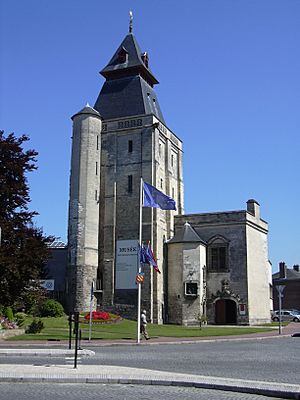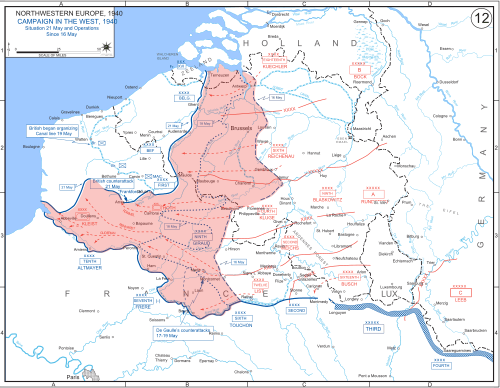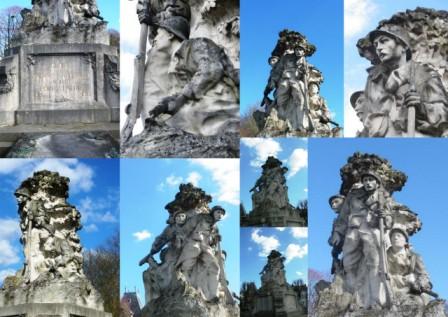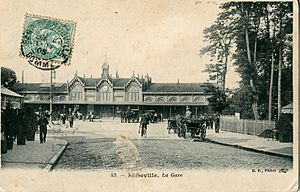Abbeville facts for kids
Quick facts for kids
Abbeville
|
||
|---|---|---|
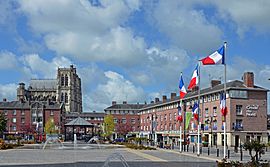
Max Lejeune square
|
||
|
||
| Country | France | |
| Region | Hauts-de-France | |
| Department | Somme | |
| Arrondissement | Abbeville | |
| Canton | Abbeville | |
| Area
1
|
26.42 km2 (10.20 sq mi) | |
| Population
(2006)
|
24,829 | |
| • Density | 939.78/km2 (2,434.0/sq mi) | |
| Time zone | UTC+01:00 (CET) | |
| • Summer (DST) | UTC+02:00 (CEST) | |
| INSEE/Postal code |
80001 /80100
|
|
| Elevation | 2–76 m (6.6–249.3 ft) (avg. 8 m or 26 ft) |
|
| 1 French Land Register data, which excludes lakes, ponds, glaciers > 1 km2 (0.386 sq mi or 247 acres) and river estuaries. | ||
Abbeville is a commune in the Somme department in Hauts-de-France in northern France.
Contents
Location
Abbeville is located on the Somme River, 20 km (12 mi) from its modern mouth in the English Channel. The majority of the town is located on the east bank of the Somme, as well as on an island. It is located at the start of the Abbeville Canal, and is 45 km (28 mi) northwest of Amiens. In the medieval period, it was the lowest crossing point on the Somme. Edward III's army crossed nearby shortly before the Battle of Crécy in 1346.
Administration
Abbeville was the capital of the former province of France of Ponthieu. Today, it is one of the three s of the Somme department.
Etymology
The Romans occupied it and named it Abbatis Villa.
Prehistory
The name Abbeville has been adopted to name a category of paleolithic stone tools. These stone tools are also known as handaxes. Various handaxes were found near Abbeville by Jacques Boucher de Perthes during the 1830s. He was the first to describe the stones in detail. He pointed out in the first publication of its kind, that the stones were chipped deliberately by early man, so as to form a tool. These stone tools which are some of the earliest found in Europe, were chipped on both sides so as to form a sharp edge, were known as 'Abbevillian' handaxes or bifaces, but recently the term 'abevillian' is becoming obsolete as the earlier form of stone tool, not found in Europe, is known as the Oldowan chopper. Some of these are displayed at the museum Boucher-de-Perthes.
A more refined form from a later period of handaxe production was found in the Abbeville/Somme River district. The more refined handaxe became known as the Acheulean industry, named after Saint-Acheul, today a suburb of Amiens. It retained some importance into the Bronze Age.
History
Abbeville during the ninth century was part of the diocese of Saint-Riquier. It was also an important fortress responsible for the defense of the Somme. Abbeville had a charter granted to it in 1184. Afterwards it was governed by the Counts of Ponthieu. Together with that county, it came into the possession of the Alençon and other French families. Afterwards it came into the possession of the House of Castile. By marriage it passed in 1272 to King Edward I of England. In 1435, by the treaty of Arras, it was to the Duke of Burgundy. In 1477 it was taken control of by King Louis XI of France,. Later it was held by two illegitimate branches of the royal family in the 16th and 17th centuries, being in 1696 returned to the crown. In 1514, the town was the place where the marriage of Louis XII of France to Mary Tudor took place. She was the daughter of Henry VII of England. In 1685, it suffered a serious economic when the Edict of Nantes was repealed. The Protestants who were the majority of the skilled labor, left town. The town never fully recovered from the loss of their talents.
Abbeville was fairly important in the 18th century. Van Robais Royal Manufacture (one of the first major factories in France) brought great prosperity to the town. Voltaire, among others, wrote about it.
Abbeville was the birthplace of Rear Admiral Amédée Courbet (1827–85). His victories on land and at sea made him a national hero during the Sino-French War (August 1884 to April 1885). Courbet died in June 1885 in the Pescadores Islands. His body was brought back to France and buried in Abbeville on 1 September 1885 after a state funeral. Abbeville's old Haymarket Square (Place du Marché-au-Blé) was renamed Place de l'Amiral Courbet in July 1885. This was shortly after the news of Courbet's death reached France. A statue of Courbet was erected in the middle of the square at the end of the nineteenth century. The statue was damaged in a bombing raid during World War II.
On 12 September 1939 in Abbeville a conference took place. There France and the United Kingdom decided it was too late to send troops to help Poland in its fight against Germany. By this time Poland was already on the verge of defeat. After five years—in September 1944—Abbeville was liberated by the Polish First Armoured Division under General Maczek.
The Blitzkrieg
In 1940, the Germans with the bulk of their armoured force in Panzer Group von Kleist achieved a breakthrough at Sedan with air support. The Panzer group raced to the coast of the English Channel at Abbeville. This isolated (20 May 1940) the British Expeditionary Force, Belgian Army, and some divisions of the French Army in northern France. The Battle of France was lost by the Allies.
Charles de Gaulle (17–18 May 1940), as a Colonel in this period, launched a in the region of Laon (see the map). He had 80 tanks to destroy the communication of the German armoured troops. His newly formed 4e Division cuirassée reached Montcornet, resulting in the Battle of Montcornet. But, without support, the 4th DCR was forced to retreat. There was another counterattack with the Battle of Abbeville. After Laon (24 May), de Gaulle was promoted to temporary general: "On 28 May (...) the 4th DCR attacked twice to destroy a pocket captured by the enemy south of the Somme near Abbeville. The operation was successful, with over 400 prisoners taken and the entire pocket mopped up except for Abbeville (...) but in the second attack the 4th DCR failed to gain control of the city in the face of superior enemy numbers." WWII was not kind to the buildings of the town as the famous 17th century Gothic Cathedral of St. Vulfran was nearly destroyed.
Economy
Abbeville manufactures ; in particular, linens and tablecloths. It also has factories and spinning mills. Finally, it also makes locks and produces sugar.
Historical population
- 1901: 18,519
- 1906: 18,971
- 1990: 23,787
- 2006: 24,829
Sights
The city was very picturesque until the early days of the World War II. It was bombed mostly to rubble in one night by the Germans. The town overall is now mostly modern and rebuilt. Several of the town's attractions remain, including:
- St. Vulfran's church, erected in the 15th, 16th and 17th centuries. The original design was not completed. The nave has only two bays and the choir is insignificant. The is an outstanding example of the flamboyant Gothic style, flanked by two Gothic towers.
- The Boucher de Perthes Museum, situated in the now unused bell tower. It is a tribute to Jacques Boucher de Crèvecœur de Perthes who also has a French public secondary school named after him. The museum features art work and other artefacts from the 16th century onwards, and other that change every few months.
- A monument aux morts (to the dead) with work by Louis-Henri Leclabart. A montage of photographs of this monument is shown below.
Transport
Abbeville is served by trains on the line between Boulogne-sur-Mer and Amiens. Abbeville was the southern terminus of the Réseau des Bains de Mer, the line to Dompierre-sur-Authie opened on 19 June 1892 and closed on 10 March 1947.
Images for kids
-
Hand axe of Menchecourt-les-Abbeville, shown at the 1867 International Exposition) – Muséum de Toulouse
See also
 In Spanish: Abbeville (Somme) para niños
In Spanish: Abbeville (Somme) para niños






